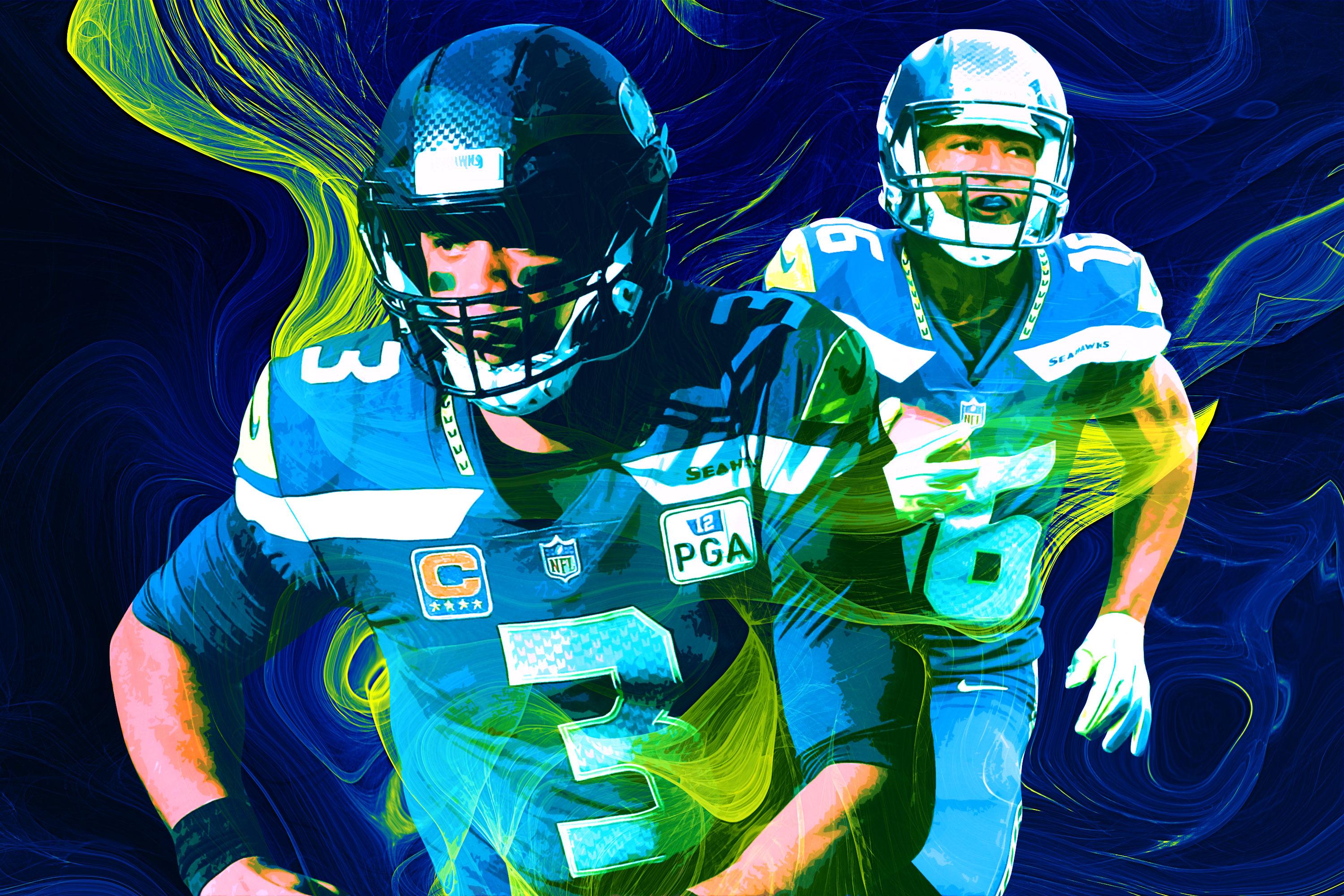
The defining narrative of the Seahawks’ season has been Pete Carroll’s almost fanatical dedication to the run game—an old-school philosophy that seems, at least on its face, to run counter to the league’s evolution toward high-octane passing attacks. A quick glance at Seattle’s run-pass splits and its total yardage this year would only support the idea that Carroll actively tried to take his offense back to the ’80s: The Seahawks finished dead last in the NFL with 427 pass attempts this season, were the only team to run the ball more times than they passed, and led the NFL in rushing while ranking 27th in passing yards, just behind the hilariously inept Blake Bortles– and Cody Kessler–led Jaguars.
But while Carroll and offensive coordinator Brian Schottenheimer leaned on a low-volume air attack, the numbers above don’t tell the whole story. The Seahawks have paired their commitment to smashmouth football with a surgical approach to the passing game, and Russell Wilson has quietly been one of the deadliest deep-ball passers in the league. When the Seahawks meet the Cowboys in Saturday’s wild-card game, we can expect a heavy dose of running backs Chris Carson, Mike Davis, and Rashaad Penny. But that trio alone won’t be enough to power Seattle to an upset. The Seahawks are going to need Wilson to be at his best throwing deep down the field—and this game is going to come down to whether the Cowboys’ talented secondary can stifle the Seahawks’ vertical passing attack.
The contrast between the Seahawks’ old-fashioned run game and their efficient downfield passing attack has made for a confusing experience—for fans and opposing defenses alike. The Seahawks have embraced the NFL’s bygone days by establishing the run, throwing body blows, imposing their will, and leaning into every other long-established run-game cliché. At times, that’s been effective, especially when Carson is leaping over or bowling through a defender for a score. At others—all those futile runs on second-and-long, for instance (only one team, the Bills, attempted more runs than Seattle on second-and-11 or more)—it hasn’t been as helpful. Crucially, though, Seattle’s offense has been far more than just its ground game, and this team has managed to throw the ball over opposing defenders’ heads at a rate that rivals even the most high-flying schemes we’re seeing take over the league.
Schottenheimer has utilized pre-snap motion, misdirection, and play-action to get guys open while Wilson has showed off his deep-ball accuracy and touch, launching precision missiles downfield to pick up huge chunks of yards. The seventh-year quarterback finished the season among the league leaders in points earned on deep passes, throwing 20-plus yards downfield on 15.9 percent of his total pass attempts, according to Pro Football Focus (tied for third most leaguewide). He tallied a deep passer rating of 128.1 (second), netting a league-high 15 touchdowns while getting picked off just once. And, despite Seattle’s run-heavy attack, Wilson finished third in the NFL in total deep passing yardage (1,108)―which ranked behind only Kansas City’s Patrick Mahomes II and Green Bay’s Aaron Rodgers.
Wilson ended the year with his fewest attempted passes since 2013, but he connected on a career-high 35 touchdown throws—tied for third in the NFL. His incredible efficiency as a deep passer played a huge part in his success this year and showed that, while the run game has been a huge part of the Seahawks’ identity on offense, the deep pass has been its points-scoring lifeblood.
That was clear during a couple of Seattle’s crucial late-season wins. In the Seahawks’ Week 12 victory over the Panthers, a late fourth-quarter deep shot from Wilson to Tyler Lockett proved to be the pivotal play of the game. With the score tied at 27 with 1:07 to go, Seattle faced a third-and-5 from its own 47-yard line. Had the Seahawks failed to convert in that spot, they risked, at worst, giving the ball back to Carolina with plenty of time to march down the field and win the game or, at best, facing overtime on the road. But when Wilson took the snap, he didn’t just look to convert the first down. He eluded pressure by sliding left, then launched a bomb down the numbers to his streaking receiver.
That play picked up 43 yards in the blink of an eye. Wilson kneeled twice then spiked it to stop the clock, setting up a game-winning field goal by Sebastian Janikowski.
A pair of late-game deep passes helped the Seahawks get a win against the Chiefs in Week 16 too. Kansas City had cut the Seahawks lead to 31-28 at the 4:43 mark of the fourth quarter and looked ready to take control of the game for good. A three-and-out was the last thing Seattle could give the Chiefs in that situation, yet instead of conservatively trying for safe, underneath passes to move the chains, Carroll instructed Schottenheimer to keep his foot on the pedal and attack deep downfield. Facing a second-and-12 from his own 34-yard line, Wilson uncorked what might be the most beautiful pass of his entire career: a long, arching dime that fell right into Lockett’s breadbasket 45 yards downfield.
Two plays later, Wilson let loose with another crucial deep pass, lofting the ball toward the pylon. Veteran receiver Doug Baldwin made an amazing play, tapping it to himself with one hand to reel it in and set up a game-sealing Chris Carson touchdown run.
The win punched Seattle’s postseason ticket, but last week, the team was playing for the fifth seed. In a closely-fought matchup with a shockingly plucky Cardinals squad, Seattle’s vertical attack came up big in the final moments of the game, again. With the score tied at 24 with 1:02 to go and the Seahawks facing a first-and-10 from their own 38-yard line, Wilson took a deep shot downfield to Lockett. The fourth-year receiver adjusted his route on the fly, choosing to run up the sideline and away from coverage instead of toward the post as the play dictated. Wilson escaped from pressure, strafed to his right, and saw Lockett alter his route, unleashing a perfect throw on the run to pick up 37 yards to move Seattle into field goal range.
Janikowski kicked the game-winner four plays later.
Wilson and his cadre of underrated pass catchers have been making the difficult look easy all year long. Some of their success on closely contested deep passes can be attributed to scheming: Seattle’s mastered the art of the play-fake—getting defenders to commit to the run before throwing it deep—and Wilson’s been one of the best play-action passers in the NFL. Some of it’s due to the talent of the team’s receiving corps: Baldwin, who’s finally getting healthy after battling a litany of injuries this year, has always been one of the NFL’s best route runners and is no stranger to highlight-reel catches; second-year pro David Moore has shown he can win in contested-ball situations; and Lockett’s emerged as one of the most dangerous deep-ball catchers in the NFL.
In fact, Lockett’s season was historic based on more than a few measures: Wilson accumulated a perfect 158.3 passer rating when targeting Lockett, who caught 57 passes for 965 yards and 10 touchdowns on the year. He became the only receiver in the Super Bowl era to compile a perfect passer rating when targeted (among those with 16-plus targets), and finished with the highest DVOA of any receiver Football Outsiders has ever tracked (their data goes back to 1986). His 13.79 yards per target is the highest ever for a receiver with at least 60 targets.
And, obviously, Wilson should get plenty of credit too. He has shown pinpoint accuracy passing down the field and has known when to launch high-velocity lasers into coverage and when to loft a pass over the outstretched hands of a defender.
These are high-difficulty throws, but the most important tenet of Carroll’s offensive philosophy is to protect the ball. Seattle managed to do just that, finishing the year with a league-low 11 turnovers. And coming in a close second among things that get Carroll pumped are explosive plays; namely, limiting them on defense and creating them on offense. Going back to Week 10, an eight-game stretch in which Seattle’s averaged 30.0 points per game (third), the Seahawks are tied for the league lead with the Chiefs in what the team considers “explosive plays”: runs of 12-plus yards and passes of 16-plus yards. They’ve gotten plenty of those from Carson, Davis, and Penny on the ground, but it’s what they’ve been able to do through the air that makes Seattle the most quietly-explosive team in the NFL.
“[Schottenheimer] has had a great season with us,” Carroll said after Seattle’s win over Kansas City. “He’s found our offense, he’s figured them out, he’s brought them together and gave us a style that we’re really proud of. I know that you think that we only want to run the football, but we don’t. We want to find ways to explode.”
The underdog Seahawks face a challenge this weekend against the Cowboys, whose foundation is a physical, athletic, and rangy defense. But Schottenheimer, Wilson, Lockett, and Baldwin’s ability to dial up and hit on a few deep shots could be what Seattle needs to come out of Dallas with a win.

